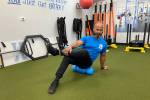Muscle-movement knowledge can help you build your back
Here's some simple science that will help you understand how lifting works.
This is best illustrated when talking about the back, but it applies just as much to all lifting.
The muscles of the back are layered one on top of the other. The muscles you see when striking a pose in the mirror are the latissimus dorsi and trapezius.
If you are really lean, you can glimpse parts of the teres major and minor as well as the infraspinatus and rhomboids. They add to the "wings" when they are developed and contribute to the "V" shape. But you'll never see those muscles in their entirety because they are under the traps and lats.
I often refer to the rhomboids as the posture muscles because they attach from the spine to the scapula. They hold the shoulders back and help keep the spine straight.
These mostly hidden muscles are just as important to condition as the more visible muscles because they contribute to your posture and safe movement. Using improper form during exercise often lets the rhomboids and core hang loose instead of supporting the trunk and spine.
To work all the muscles in your back, it helps to understand which movements work them in which way. Muscles perform three basic movements: concentric, isometric and eccentric.
A concentric movement is the contraction of a muscle. The way I remember it is that concentric and contract both start with the letter "C."
When a muscle holds its position it is stabilizing isometrically. Letting the weight back down, with control, is an eccentric movement.
For example, when performing a row, pulling toward the body with your arms is the concentric motion. Holding the weight before letting it back down is isometric, and letting the weight back down is eccentric.
When you work the back, all of these movements are present in different muscles. When you contract the core and tighten the upper back in preparation for doing a row, you require your muscles to isometrically stabilize your body. The lower back and some of the upper back are involved. These concentric and eccentric movements are performed mostly by the lats and traps.
Knowing this, you can see why it is important to have the core tight and the upper back contracted. This locks the spine in a straight position by isometrically stabilizing it. Simply performing a row or pull-up is not enough. The body needs to be stable and the weight needs to be controlled throughout the movement.
Performing back exercises by throwing weight around with a loose core and curved back will lead to muscle imbalance and injury.
Doing the exercises I've chosen today, you will notice the different muscle movements. They both require the lower back to stabilize and the upper back to be contracted in isometric positions. The concentric contraction will be the familiar part to experienced gymgoers. By controlling the eccentric motion, you will make sure the weight you have loaded doesn't throw you around.
Chris Huth is a Las Vegas trainer. You can contact him at 702trainer@gmail.com. Before beginning any exercise program, consult your physician.































